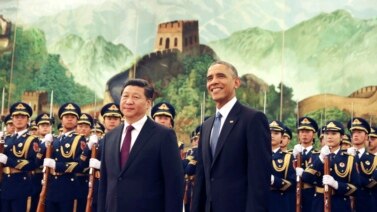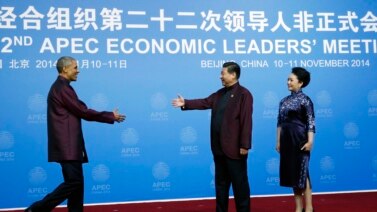The longest railway in the world is now open. In December, a train carrying products from China arrived in Spain’s capital, Madrid. The railway is one of the most recent transportation projects that China has financed in Europe. Some call the railway the “21th Century Silk Road.” China is paying to improve roads, bridges and railroads to increase trade between East Asia and Europe. The European Union is China’s biggest trading partner, and Europe is welcoming the money China is spending to improve infrastructure.
The train carried 40 containers and travelled 13,000 kilometers. It began in Yiwu, a Chinese city in the coastal province of Zhejiang, in November. It arrived in Madrid three weeks later. A ship would take about six weeks to make the same trip.
The train is to return to China with Spanish wine and food before the beginning of the Chinese New Year in February.
Jonathan Fenby wrote the book “Will China Dominate the 21th Century?” He says China has just begun its efforts to improve trade routes.
“These things are, are developing and they are going to go on developing, I think. There is a rail link now from Chongqing in southwest China through Russia, which ends in Duisberg in Germany.”
Trains now travel between Germany and China five times a week.
China is investing a lot of money to improve bridges and roads in Europe. It recently paid $167 million to build a bridge over the Danube river in Serbia. Chinese Premier Li Keqiang went to the opening ceremony. Serbian Prime Minister Aleksandar Vucic said the bridge is the first of many investments China will make in his country.
He says the bridge is a sign of friendship between China and Serbia. He adds that there will be more such projects with China, including, in his words, new bridges and new paths to the future.
Those plans include building a high-speed rail link between Belgrade and Budapest in Hungary at a cost of $1.9 billion. Chinese Foreign Minister Wang Yi says the money his country is spending shows China is taking a new approach to relations with other countries.
He says by the end of 2014 China had created 70 relationships with countries and areas around the world. He says China is building partnerships, rather than alliances.
China has promised to spend $40 billion to improve infrastructure. The investments make China’s presence known around the world. However, Mr. Fenby says it is also doing so because growth in China has slowed.
“(There are) a lot of structural weaknesses in China -- everything from the financial system to the environment. And we’re at a point now where I think the present Chinese leadership first of all is ready to accept slower growth. But also there is an awareness in China of the need to get to grips with all these big problems.”
Observers say European countries have lessened their criticisms of China’s poor record for human rights and political reform as China has improved Europe’s infrastructure.
I’m Christopher Cruise.
Correspondent Henry Ridgwell reported from London. Christopher Cruise wrote the story for VOA Learning English. Mario Ritter was the editor.
Words in This Story
infrastructure – n. structures and centers needed to operate an enterprise or a society, such as roads, bridges and electrical plants
container – n. very large shipping boxes used to transport goods, often over long distances
approach – n. a way of doing something, or dealing with something
partnerships – n. a business that is jointly owned; a joint effort or project between partners
alliances – n. people or countries joined for a special purpose
get to grips with (British idiom; the American English version of this idiom is: “come to grips with”) – idiom. to deal with
What do you think about China’s plan to spend billions of dollars improving infrastructure in Europe? Do you believe nations in which China has invested should reduce their criticisms of China’s poor human rights record and democracy policies? We want to hear from you. Write your thoughts in the comments section.



